Bois de sciage orienté
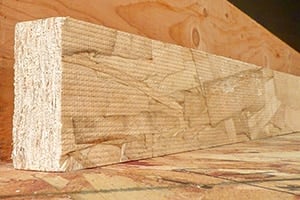
Bois de sciage orienté (OSL) Le bois de sciage orienté (OSL) présente des caractéristiques telles qu'une grande résistance, une grande rigidité et une grande stabilité dimensionnelle. Le processus de fabrication de l'OSL permet de produire de grandes pièces à partir d'arbres relativement petits, ce qui permet une utilisation efficace des ressources forestières. L'OSL est principalement utilisé comme ossature structurelle dans la construction résidentielle, commerciale et industrielle. Les applications courantes de l'OSL dans la construction comprennent les chevêtres et les poutres, les montants des murs hauts, les planches de rive, les plaques d'appui, la menuiserie et l'encadrement des fenêtres. L'OSL offre également une bonne résistance aux fixations. Comme le bois lamellé-collé, l'OSL est fabriqué à partir de lamelles de bois dont le rapport longueur/épaisseur est d'environ 75. Les brins de bois utilisés dans l'OSL sont plus courts que ceux du LSL. Combinés à un adhésif, les brins sont orientés et formés en un grand mat ou billette, puis pressés. L'OSL ressemble au panneau à lamelles orientées (OSB), car ils sont tous deux fabriqués à partir d'essences de bois similaires et contiennent des lamelles de bois, mais, contrairement à l'OSB, les lamelles de l'OSL sont disposées parallèlement à l'axe longitudinal de l'élément. L'OSL est un produit d'ingénierie en bois solide, hautement prévisible et uniforme, car les défauts naturels tels que les nœuds, l'inclinaison du grain et les fentes ont été dispersés dans tout le matériau ou ont été complètement éliminés au cours du processus de fabrication. Comme d'autres produits SCL tels que le LVL et le PSL, l'OSL offre des propriétés de résistance et de rigidité prévisibles et une stabilité dimensionnelle qui minimise la torsion et le retrait. Toutes les coupes, entailles ou perçages spéciaux doivent être effectués conformément aux recommandations du fabricant. Les catalogues et les rapports d'évaluation des fabricants sont les principales sources d'information pour la conception, les détails d'installation typiques et les caractéristiques de performance. Comme tout autre produit en bois, l'OSL doit être protégé des intempéries pendant l'entreposage sur le chantier et après l'installation. L'emballage du produit avant son expédition sur le chantier est important pour assurer la protection contre l'humidité. Le scellement des extrémités et des bords du produit renforcera sa résistance à la pénétration de l'humidité. OSL est un produit breveté et, par conséquent, les propriétés techniques et les dimensions spécifiques sont propres à chaque fabricant. Il n'existe donc pas de normes de production ni de valeurs de conception communes pour l'OSL. Les valeurs de conception sont dérivées des résultats d'essais analysés conformément à la norme CSA O86 et à la norme ASTM D5456 et les valeurs de conception sont examinées et approuvées par le Centre canadien des matériaux de construction (CCMC). Les produits conformes aux directives du CCMC reçoivent un numéro d'évaluation et un rapport d'évaluation comprenant les résistances nominales spécifiées, qui sont ensuite répertoriées dans le registre des évaluations de produits du CCMC. Le nom du fabricant ou l'identification du produit et la classe de contrainte sont marqués sur le matériau à différents intervalles, mais en raison de la coupe en bout, ils peuvent ne pas être présents sur chaque pièce. Pour de plus amples informations, veuillez consulter les ressources suivantes : APA - The Engineered Wood Association Centre canadien des matériaux de construction (CCMC), Institut de recherche en construction CSA O86 Engineering design in wood ASTM D5456 Standard Specification for Evaluation of Structural Composite Lumber Products
Bois de sciage à fils parallèles
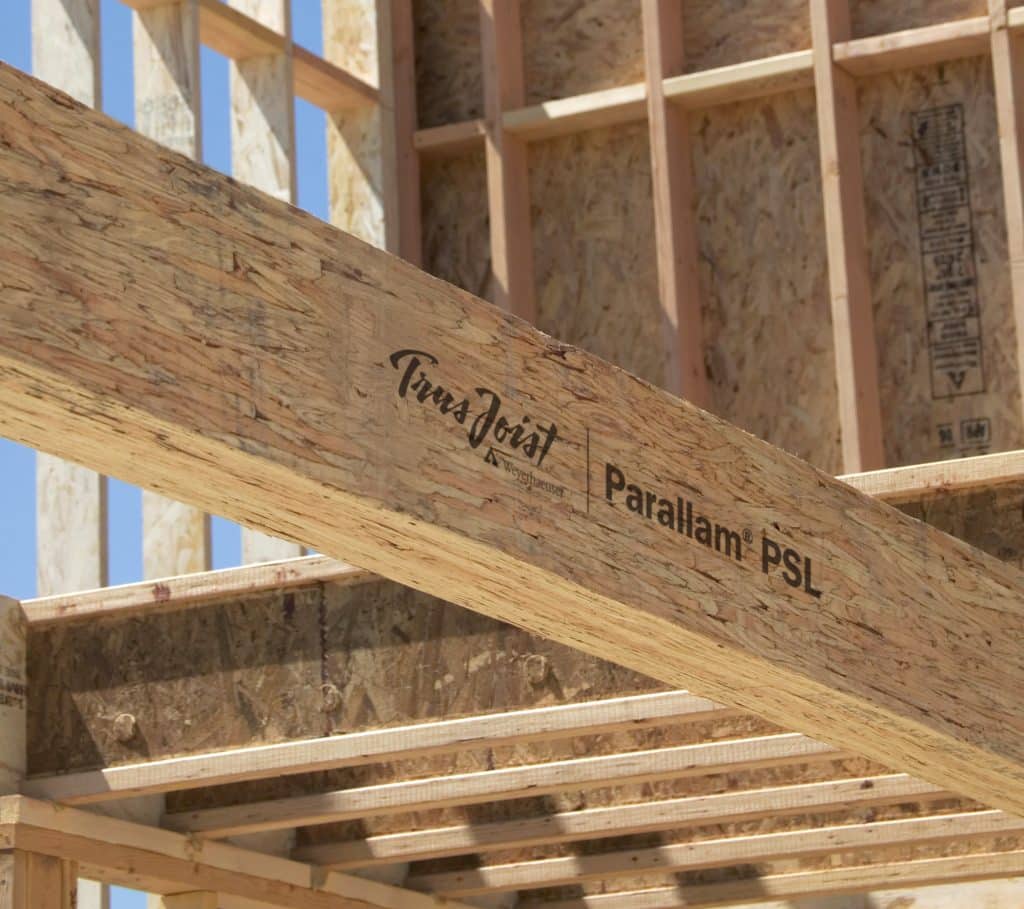
Parallel Strand Lumber (PSL) Le Parallel Strand Lumber (PSL) offre des caractéristiques telles qu'une grande résistance, une grande rigidité et une grande stabilité dimensionnelle. Le processus de fabrication du PSL permet de fabriquer de grandes pièces à partir d'arbres relativement petits, ce qui permet une utilisation efficace des ressources forestières. Au Canada, le PSL est fabriqué à partir de Douglas taxifolié. Le PSL est principalement utilisé comme ossature structurelle dans la construction résidentielle, commerciale et industrielle. Les applications courantes du PSL dans la construction comprennent les chevêtres, les poutres et les linteaux dans les constructions à ossature légère, ainsi que les poutres et les colonnes dans les constructions à poteaux et à poutres. Le PSL est un matériau structurel attrayant qui convient aux applications où l'aspect fini est important. Comme le bois lamellé-collé (LSL) et le bois orienté (OSL), le PSL est fabriqué à partir de lamelles de bois disposées parallèlement à l'axe longitudinal de la pièce et dont le rapport longueur/épaisseur est d'environ 300. Les brins de bois utilisés dans le PSL sont plus longs que ceux utilisés pour fabriquer le LSL et l'OSL. Combinées à un adhésif phénol-formaldéhyde imperméable à l'extérieur, les lamelles sont orientées et formées en une grande billette, puis pressées ensemble et durcies à l'aide d'un rayonnement micro-ondes. Les poutres PSL sont disponibles en épaisseurs de 68 mm (2-11/16 in), 89 mm (3-1/2 in), 133 mm (5-1/4 in), et 178 mm (7 in) et une profondeur maximale de 457 mm (18 in). Les colonnes PSL sont disponibles en dimensions carrées ou rectangulaires de 89 mm (3-1/2 po), 133 mm (5-1/4 po) et 178 mm (7 po). Les épaisseurs les plus faibles peuvent être utilisées individuellement en tant que couches simples ou être combinées pour des applications multicouches. Le PSL peut être fabriqué en grandes longueurs, mais il est généralement limité à 20 m par les contraintes de transport. Le PSL est un produit en bois massif, hautement prévisible et uniforme, car les défauts naturels tels que les nœuds, l'inclinaison des fibres et les fentes ont été dispersés dans l'ensemble du matériau ou ont été entièrement éliminés au cours du processus de fabrication. Comme les autres produits SCL (LVL, LSL et OSL), le PSL offre des propriétés de résistance et de rigidité prévisibles ainsi qu'une stabilité dimensionnelle. Fabriqué à un taux d'humidité de 11 %, le PSL est moins sujet au rétrécissement, au gauchissement, à la déformation, à la courbure et au fendillement. Toutes les coupes, entailles ou perçages spéciaux doivent être effectués conformément aux recommandations du fabricant. Les catalogues et les rapports d'évaluation des fabricants sont les principales sources d'information pour la conception, les détails d'installation typiques et les caractéristiques de performance. Le PSL présente une texture riche et conserve de nombreuses lignes de colle foncées. Le PSL peut être usiné, teinté et fini en utilisant les techniques applicables au bois de sciage. Les éléments en PSL acceptent facilement la teinture pour rehausser la chaleur et la texture du bois. Tous les panneaux PSL sont poncés à la fin du processus de production afin de garantir des dimensions précises et d'obtenir une surface de haute qualité pour l'apparence. Comme tout autre produit en bois, le PSL doit être protégé des intempéries pendant l'entreposage sur le chantier et après l'installation. L'emballage du produit avant son expédition sur le chantier est important pour assurer la protection contre l'humidité. Le scellement des extrémités et des bords du produit renforce sa résistance à la pénétration de l'humidité. Le PSL accepte facilement un traitement de préservation et il est possible d'obtenir un degré élevé de pénétration du produit. Le PSL traité peut être spécifié pour les expositions à une humidité élevée. Le PSL est un produit breveté et, par conséquent, les propriétés techniques et les dimensions spécifiques sont propres à chaque fabricant. Il n'existe donc pas de normes de production ni de valeurs de conception communes pour le PSL. Les valeurs de conception sont dérivées des résultats d'essais analysés conformément à la norme CSA O86 et à la norme ASTM D5456 et les valeurs de conception sont examinées et approuvées par le Centre canadien des matériaux de construction (CCMC). Les produits conformes aux directives du CCMC reçoivent un numéro d'évaluation et un rapport d'évaluation comprenant les résistances nominales spécifiées, qui sont ensuite répertoriées dans le registre des évaluations de produits du CCMC. Le nom du fabricant ou l'identification du produit et la classe de résistance sont marqués sur le matériau à différents intervalles, mais en raison de la coupe en bout, ils peuvent ne pas être présents sur chaque pièce. Le Centre canadien des matériaux de construction (CCMC) a accepté que le PSL soit utilisé pour la construction de bois lourds, conformément aux dispositions de la partie 3 du Code national du bâtiment du Canada. Pour de plus amples informations, veuillez consulter les ressources suivantes : APA - The Engineered Wood Association Centre canadien des matériaux de construction (CCMC), Institut de recherche en construction CSA O86 Engineering design in wood ASTM D5456 Standard Specification for Evaluation of Structural Composite Lumber Products
Bois dans les bâtiments incombustibles
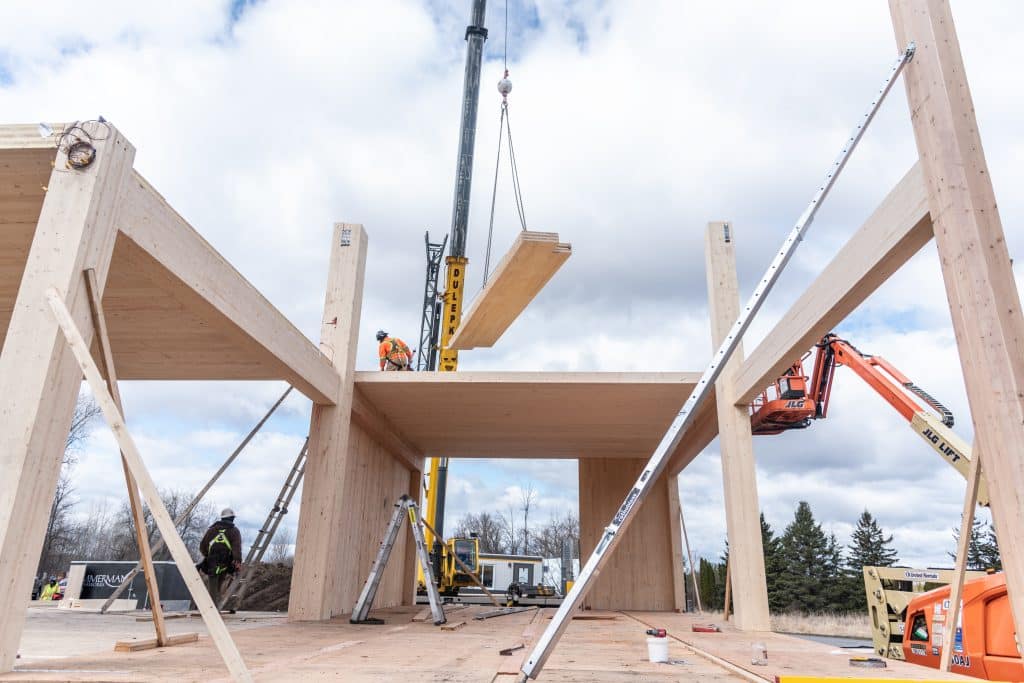
Le Code national du bâtiment du Canada (CNB) exige que certains bâtiments soient de "construction incombustible" en vertu de ses exigences normatives. Le terme "construction incombustible" est toutefois mal choisi, car il n'exclut pas l'utilisation de matériaux "combustibles", mais en limite plutôt l'usage. Certains matériaux combustibles peuvent être utilisés car il n'est ni économique ni pratique de construire un bâtiment entièrement en matériaux "incombustibles". Le bois est probablement le matériau combustible le plus utilisé dans les bâtiments incombustibles et a de nombreuses applications dans les bâtiments classés comme constructions incombustibles par le CNB. En effet, les réglementations en matière de construction ne reposent pas uniquement sur l'utilisation de matériaux incombustibles pour atteindre un niveau acceptable de sécurité incendie. De nombreux matériaux combustibles sont autorisés dans les espaces cachés et dans les zones où, en cas d'incendie, ils ne risquent pas d'affecter sérieusement les autres caractéristiques de sécurité incendie du bâtiment. Par exemple, il existe des autorisations pour l'utilisation de constructions en bois lourd pour les toits et les supports structurels des toits. Il peut également être utilisé pour les cloisons et les finitions murales, ainsi que pour les bandes de fourrure, les bordures de toit et les auvents, les bandes de cantonnement, les bordures de toit, les pare-feu, les revêtements de toit, les menuiseries, les armoires, les comptoirs, les châssis de fenêtre, les portes et les planchers. Son utilisation dans certains types de bâtiments tels que les bâtiments de grande hauteur est légèrement plus limitée dans des zones telles que les sorties, les couloirs et les halls d'entrée, mais même là, des traitements ignifuges peuvent être utilisés pour répondre aux exigences du CNB. Le CNB autorise également l'utilisation de bardages en bois pour les bâtiments désignés comme étant de construction incombustible. Dans les bâtiments incombustibles protégés par gicleurs d'une hauteur maximale de deux étages, les toits entiers et les supports de toit peuvent être construits en bois massif. Pour être acceptables, les éléments en bois lourd doivent respecter des exigences minimales en matière de dimensions et d'installation. La construction en bois massif bénéficie de cette reconnaissance en raison de ses performances en cas d'exposition réelle au feu et de son acceptation en tant que méthode de construction sûre en cas d'incendie. L'expérience des pertes dues aux incendies a montré, même dans les bâtiments non protégés par des gicleurs, que la construction en bois massif est supérieure aux toitures incombustibles n'ayant pas de degré de résistance au feu. Dans d'autres bâtiments incombustibles, la construction en bois massif, y compris les planchers, est autorisée sans que le bâtiment soit protégé par gicleurs. Dans les bâtiments protégés par sprinklers dont la construction combustible est autorisée, aucun degré de résistance au feu n'est requis pour la toiture ou ses supports lorsqu'ils sont construits en bois massif. Dans ces cas, une toiture en bois lourd et ses supports n'ont pas à se conformer aux dimensions minimales des éléments stipulées dans le CNB. Définitions du CNB : Combustible signifie qu'un matériau ne satisfait pas aux critères d'acceptation de la norme CAN/ULC-S114, " Essai de détermination de l'incombustibilité des matériaux de construction ". On entend par construction combustible le type de construction qui ne répond pas aux exigences de la construction incombustible. Construction en bois lourd : ce type de construction combustible dans laquelle un certain degré de sécurité incendie est atteint en limitant les dimensions des éléments structurels en bois ainsi que l'épaisseur et la composition des planchers et des toits en bois, et en évitant les espaces cachés sous les planchers et les toits. Construction incombustible : type de construction dans lequel un degré de sécurité incendie est atteint par l'utilisation de matériaux incombustibles pour les éléments de structure et autres assemblages de bâtiments. Incombustible signifie qu'un matériau répond aux critères d'acceptation de la norme CAN/ULC-S114, "Essai de détermination de l'incombustibilité des matériaux de construction". Pour de plus amples informations, veuillez consulter les ressources suivantes : Manuel de conception du bois, Conseil canadien du bois Code national du bâtiment du Canada CAN/ULC-S114 Essai de détermination de l'incombustibilité des matériaux de construction Escaliers et casiers de rangement dans les bâtiments incombustibles Les escaliers à l'intérieur d'un logement peuvent être en bois, de même que les casiers de rangement dans les bâtiments résidentiels. Ils sont autorisés, car leur utilisation ne devrait pas présenter un risque d'incendie important. Matériaux de couverture en bois dans les bâtiments incombustibles Lors de l'installation de la couverture, il est possible d'utiliser des bandes de cantonnement en bois, des bordures de toit, des bandes de clouage et d'autres éléments similaires. Les toits en bois définis comme "construction en bois lourde" dans le CNB sont autorisés dans tout bâtiment incombustible d'une hauteur de deux étages ou moins lorsque le bâtiment est protégé par un système d'extincteurs automatiques. Le revêtement de toit et les supports de revêtement en bois sont autorisés dans les bâtiments incombustibles à condition que les parapets incombustibles soient en bois : Les parapets et les fûts incombustibles doivent empêcher les matériaux de toiture de s'enflammer à partir de flammes dépassant des ouvertures de la façade du bâtiment ou de la terrasse du toit. La plupart des couvertures de toit, même aujourd'hui, sont combustibles en raison de la nature même des matériaux utilisés pour les rendre imperméables. L'objectif du CNB est d'exiger que les risques associés à une couverture de toit soient minimisés pour le type de bâtiment, son emplacement et son utilisation. Le CNB permet d'utiliser des couvertures de toit qui satisfont à la classe C pour tout bâtiment régi par la partie 3, y compris tout bâtiment incombustible, quelle que soit sa hauteur ou sa superficie. Cet indice C peut être facilement atteint en utilisant des bardeaux de bois traités avec un fire-retardateur (FRTW), des bardeaux d'asphalte ou des rouleaux de toiture. Dans les bâtiments dont la construction doit être incombustible, les couvertures de toit doivent être classées dans la catégorie A, B ou C. Dans ce cas, l'utilisation de bardeaux en bois traité contre le feu sur les toits en pente est autorisée. Les petits bâtiments à usage collectif dont la hauteur ne dépasse pas deux étages et dont la surface de construction est inférieure à 1 000 m2 (10 000 pi2) n'ont pas besoin d'une classification pour la couverture du toit. Dans ces cas traditionnels, les bardeaux de bois non traités sont acceptables s'ils sont recouverts d'un matériau incombustible afin de réduire le risque de brûlure. Cloisons en bois dans les bâtiments incombustibles L'ossature en bois a de nombreuses applications dans les cloisons des bâtiments de faible et de grande hauteur qui doivent être de construction incombustible. L'ossature peut être placée dans la plupart des types de cloisons, avec ou sans indice de résistance au feu. L'ossature et le revêtement en bois sont autorisés dans les cloisons, ou bien des cloisons en bois massif d'au moins 38 mm (2 po nominal) d'épaisseur sont autorisées, à condition qu'il y ait un indice de résistance fire : L'ossature en bois est autorisée dans les cloisons dans toutes les zones de plancher et peut être utilisée dans la plupart des séparations de fire sans limite de taille de compartiment ni nécessité d'une protection par gicleurs : De même, en tant qu'élément final
Bois lamellé-croisé (CLT)
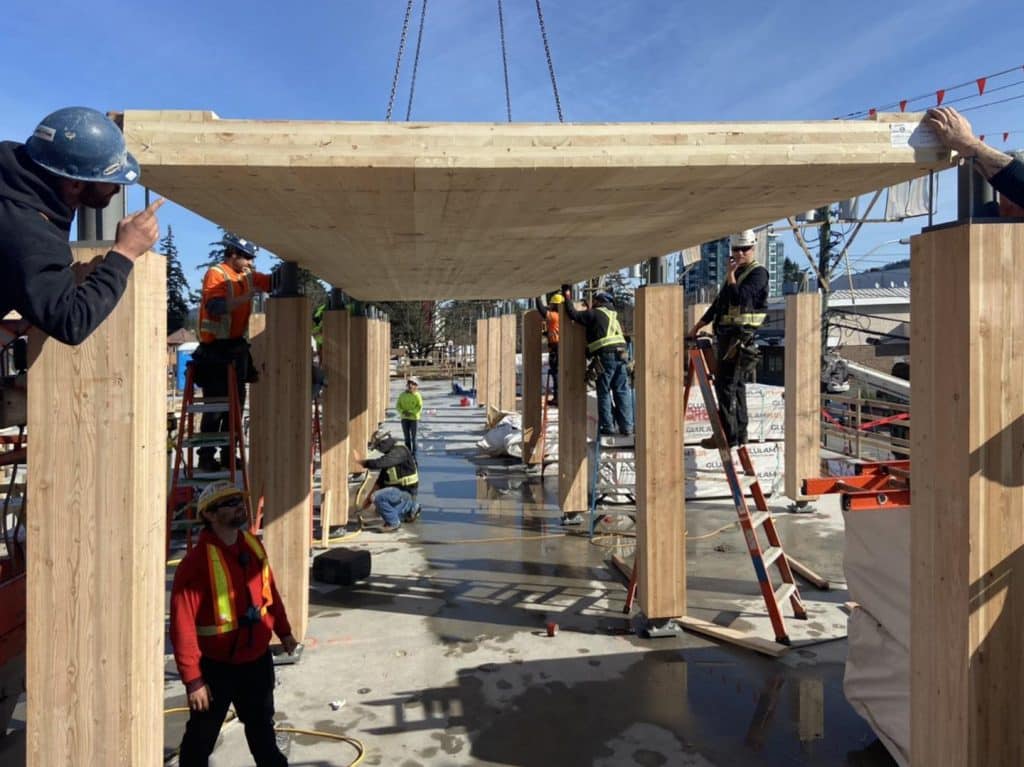
Le bois lamellé-croisé (CLT) est un produit d'ingénierie en bois breveté qui est préfabriqué à l'aide de plusieurs couches de bois d'œuvre séché au four, posées à plat et collées ensemble sur leurs faces larges. Les panneaux sont généralement constitués de trois, cinq, sept ou neuf couches alternées de bois de construction. L'alternance des directions des lamelles du CLT lui confère une grande stabilité dimensionnelle. Le CLT présente également un rapport résistance/poids élevé, ainsi que des avantages en termes de performances structurelles, thermiques, acoustiques et de résistance au feu. L'épaisseur des panneaux est généralement comprise entre 100 et 300 mm (4 à 12 pouces), mais il est possible de produire des panneaux d'une épaisseur allant jusqu'à 500 mm (20 pouces). Les dimensions des panneaux vont de 1,2 à 3 m de largeur et de 5 à 19,5 m de longueur. La taille maximale des panneaux est limitée par la taille de la presse du fabricant et par les réglementations en matière de transport. Les dispositions de conception du CLT au Canada s'appliquent aux panneaux de bois scié fabriqués conformément à la norme ANSI/APA PRG 320. En règle générale, toutes les lamelles dans une direction sont fabriquées avec la même qualité et la même essence de bois. Toutefois, les couches adjacentes peuvent avoir une épaisseur différente et être fabriquées dans d'autres qualités ou essences. La teneur en humidité des lamelles de bois d'œuvre au moment de la fabrication du CLT est comprise entre 9 et 15%. Il existe cinq catégories principales de contraintes pour le CLT : E1, E2, E3, V1 et V2. La classe de contrainte E1 est la plus facilement disponible. La désignation "E" indique que le bois est soumis à des contraintes mécaniques (MSR ou E) et la désignation "V" indique que le bois est classé visuellement. Les qualités de contrainte E1, E2 et E3 se composent de bois MSR dans toutes les couches longitudinales et de bois classé visuellement dans les couches transversales, tandis que les qualités de contrainte V1 et V2 se composent de bois classé visuellement dans les couches longitudinales et transversales. Les propriétés des qualités de contraintes du CLT sur mesure sont également publiées par les différents fabricants. Comme pour d'autres produits structuraux en bois, le CLT peut être évalué par le Centre canadien des matériaux de construction (CCMC) afin d'établir un rapport d'évaluation du produit. Contrairement aux classes de contraintes primaires et personnalisées du CLT qui sont associées à la capacité structurelle, les classes d'apparence se réfèrent à la finition de la surface des panneaux CLT. Toute classe de contrainte peut généralement être produite dans n'importe quelle finition de surface souhaitée par le concepteur. Il faut tenir compte des réductions de résistance et de rigidité dues au profilage des panneaux ou à d'autres finitions des faces ou des bords. L'annexe de la norme ANSI/APA PRG 320 donne des exemples de classifications de l'aspect du CLT. Les adhésifs structurels utilisés pour coller les laminés doivent être conformes aux normes CSA O112.10 et ASTM D7247 et sont également évalués en termes de résistance à la chaleur lors d'une exposition au feu. Les différentes classes d'adhésifs structuraux généralement utilisées sont les suivantes : Polymère isocyanate en émulsion (EPI) ; polyuréthane monocomposant (PUR) ; types phénoliques tels que le phénol-résorcinol-formaldéhyde (PRF). Étant donné que le traitement sous pression avec des produits de conservation à base d'eau peut avoir un effet négatif sur l'adhérence, il est interdit de traiter le CLT avec des produits de conservation à base d'eau après le collage. Pour le CLT traité avec des produits ignifuges ou d'autres produits chimiques susceptibles de réduire la résistance, la résistance et la rigidité doivent être basées sur des résultats d'essais documentés. Dans le cadre du processus de préfabrication, les panneaux CLT sont découpés sur mesure, y compris les ouvertures de portes et de fenêtres, à l'aide de défonceuses à commande numérique par ordinateur (CNC) ultramodernes, capables de réaliser des coupes complexes avec de faibles tolérances. Les éléments préfabriqués en CLT arrivent sur le chantier prêts à être installés immédiatement. Le CLT offre une grande souplesse de conception et un faible impact sur l'environnement pour les planchers, les toits et les murs des bâtiments innovants en bois de moyenne et grande hauteur. Pour de plus amples informations sur le CLT, veuillez consulter les ressources suivantes : Kalesnikoff Nordic Structures APA - The Engineered Wood Association Centre canadien des matériaux de construction (CCMC) Element5 ANSI/APA PRG 320 Standard for Performance-Rated Cross-Laminated Timber CSA O86 Engineering design in wood CSA O112.10 Evaluation of Adhesives for Structural Wood Products (Limited Moisture Exposure) ASTM D7247 Standard Test Method for Evaluating the Shear Strength of Adhesive Bonds in Laminated Wood Products at Elevated Temperatures
CSA O86 Conception technique du bois
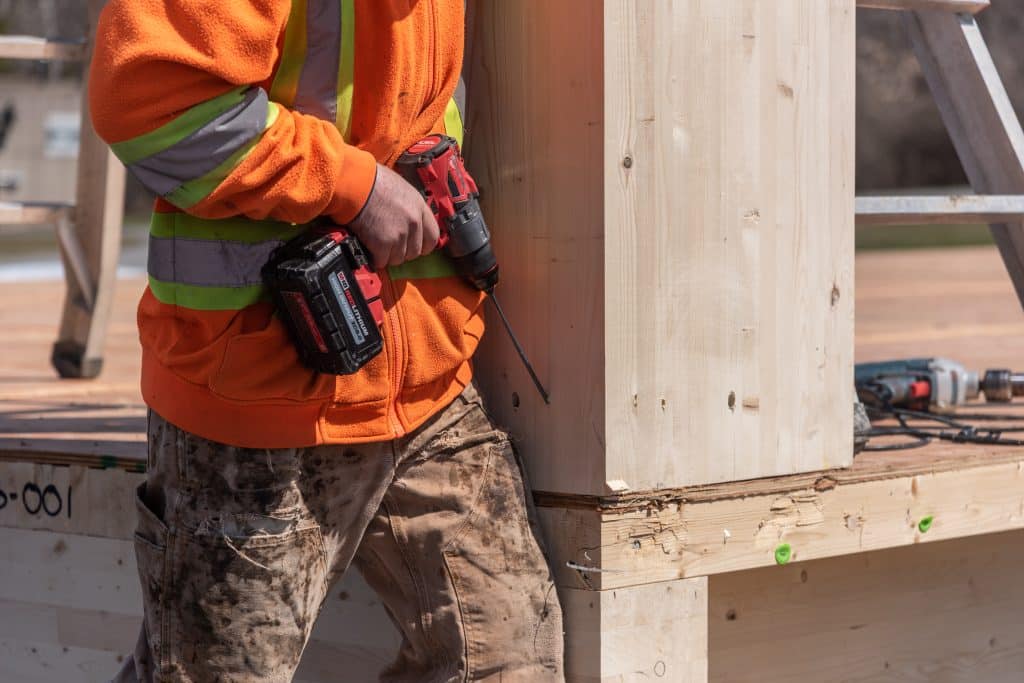
CSA O86 Conception technique du bois Le Code national du bâtiment du Canada (CNB) contient des exigences relatives à la conception technique des produits et systèmes structuraux en bois. La norme CSA O86 est citée en référence dans la partie 4 du CNB et dans les codes du bâtiment provinciaux pour la conception technique des produits structuraux en bois. La première édition de la norme CSA O86 a été publiée en 1959. La norme CSA O86 fournit des critères pour la conception structurale et l'évaluation des structures ou des éléments structuraux en bois. Elle est rédigée dans le format du calcul aux états limites et fournit des équations de résistance et des valeurs de résistance spécifiées pour les produits structuraux en bois, y compris : le bois d'œuvre classé, le bois lamellé-collé, le bois lamellé-croisé (CLT), le contreplaqué sans sable, les panneaux de particules orientées (OSB), les éléments de construction composites, les murs de cisaillement et les diaphragmes à ossature légère, les pilotis en bois, les constructions sur poteaux, les solives en I préfabriquées en bois, les produits en bois composite structural (SCL), les fondations permanentes en bois (PWF) et leurs assemblages structuraux. La norme CSA O86 fournit des approches rationnelles pour les vérifications de conception structurale liées aux états limites ultimes, tels que la flexion, le cisaillement et les appuis, ainsi qu'aux états limites d'aptitude au service, tels que la déflexion et la vibration. La norme CSA O86 contient également des facteurs de modification de la résistance pour les comportements liés à la durée de la charge, aux effets de taille, aux conditions de service, à la stabilité latérale, aux effets de système, aux traitements de préservation et ignifuges, aux entailles, à l'élancement et à la longueur de l'appui. La conception structurelle des bâtiments et des éléments en bois est réalisée à l'aide des charges définies dans la partie 4 du CNB et des valeurs de résistance des matériaux obtenues à l'aide de la norme CSA O86. Les habitations et autres petits bâtiments peuvent être construits sans conception structurelle complète en utilisant les exigences normatives décrites dans la partie 9 "Habitations et petits bâtiments" du CNB. Pour de plus amples informations, veuillez consulter les ressources suivantes : Manuel de conception en bois (Conseil canadien du bois) Introduction à la conception en bois (Conseil canadien du bois) Code national du bâtiment du Canada CSA O86 Conception technique en bois
Glulam
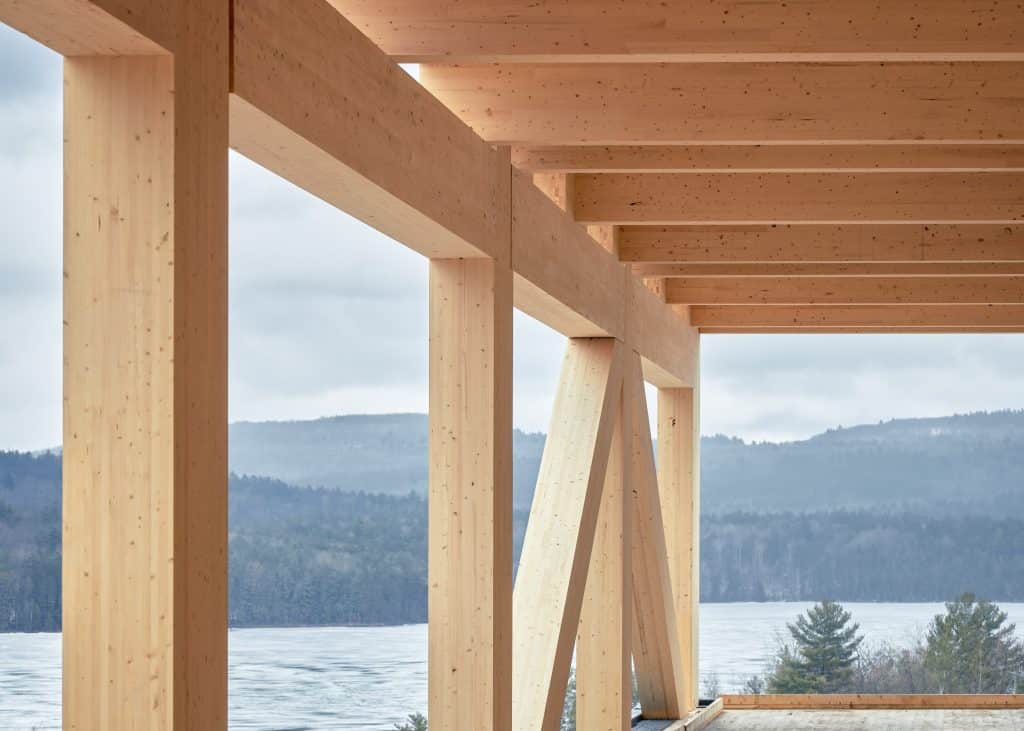
Le bois lamellé-collé est un produit structurel en bois d'ingénierie constitué de plusieurs couches individuelles de bois de dimension qui sont collées ensemble dans des conditions contrôlées. Tous les bois lamellés-collés canadiens sont fabriqués à l'aide d'adhésifs imperméables pour l'assemblage des extrémités et pour le collage des faces, et conviennent donc aussi bien aux applications extérieures qu'intérieures. Le bois lamellé-collé possède une grande capacité structurelle et constitue également un matériau de construction architectural attrayant. Le bois lamellé-collé est couramment utilisé dans les structures à poteaux et à poutres, les structures en bois lourd et en bois de masse, ainsi que dans les ponts en bois. Le bois lamellé-collé est un produit structurel en bois d'ingénierie utilisé pour les chevêtres, les poutres, les poutrelles, les pannes, les colonnes et les fermes lourdes. Le bois lamellé-collé est également fabriqué sous forme d'éléments courbes, qui sont généralement soumis à des charges combinées de flexion et de compression. Il peut également être façonné pour créer des poutres coniques inclinées et une variété de configurations d'arcs et de fermes portantes. Le bois lamellé-collé est souvent utilisé lorsque les éléments structurels sont laissés apparents, ce qui constitue un élément architectural. Dimensions disponibles pour le bois lamellé-collé Des dimensions standard ont été mises au point pour le bois lamellé-collé canadien afin de permettre une utilisation optimale du bois d'œuvre, dont les dimensions sont multiples de celles du lamstock utilisé pour la fabrication du bois lamellé-collé. Adaptées à la plupart des applications, les dimensions standard permettent au concepteur de réaliser des économies et de bénéficier d'une livraison rapide. D'autres dimensions non standard peuvent être commandées spécialement, moyennant un coût supplémentaire en raison de l'éboutage supplémentaire nécessaire pour produire des dimensions non standard. Les largeurs et profondeurs standard du bois lamellé-collé sont indiquées dans le tableau 6.7 ci-dessous. La profondeur du bois lamellé-collé est fonction du nombre de lamelles multiplié par l'épaisseur de la lamelle. Par souci d'économie, des lamelles de 38 mm sont utilisées dans la mesure du possible, et des lamelles de 19 mm sont utilisées lorsque des degrés de courbure plus importants sont requis. Largeurs standard du bois lamellé-collé Les largeurs finies standard des éléments en bois lamellé-collé et les largeurs courantes des laminés à partir desquels ils sont fabriqués sont indiquées dans le tableau 4 ci-dessous. Pour les éléments d'une largeur inférieure à 275 mm (10-7/8″), une seule largeur est utilisée pour la dimension complète de la largeur. Toutefois, les éléments d'une largeur supérieure à 175 mm (6-7/8″) peuvent être constitués de deux planches posées côte à côte. Tous les éléments d'une largeur supérieure à 275 mm (10-7/8″) sont constitués de deux pièces de bois placées côte à côte, les joints de bordures étant décalés dans la profondeur de l'élément. Les éléments d'une largeur supérieure à 365 mm (14-1/4″) sont fabriqués par incréments de 50 mm (2″), mais sont plus chers que les largeurs standard. Les fabricants doivent être consultés pour obtenir des conseils. Largeur initiale du bois lamellé-collé Largeur finale du bois lamellé-collé mm. in. mm. in. 89 3-1/2 80 3 140 5-1/2 130 5 184 7-1/4 175 6-7/8 235 (ou 89 + 140) 9-1/4 (ou 3-1/2 + 5-1/2) 225 (ou 215) 8-7/8 (ou 8-1/2) 286 (ou 89 + 184) 11-1/4 (ou 3-1/2 + 7-1/4) 275 (ou 265) 10-7/8 (ou 10-1/4) 140 + 184 5-1/2 + 7-1/4 315 12-1/4 140 + 235 5-1/2 + 9-1/4 365 14-1/4 Remarques : Les éléments d'une largeur supérieure à 365 mm (14-1/4″) sont disponibles par incréments de 50 mm (2″) mais nécessitent une commande spéciale. Les éléments d'une largeur supérieure à 175 mm (6-7/8″) peuvent être constitués de deux panneaux posés côte à côte avec des joints logitudinaux décalés dans les lamelles adjacentes. Profondeurs standard du bois lamellé-collé Les profondeurs standard des éléments en bois lamellé-collé vont de 114 mm (4-1/2″) à 2128 mm (7′) ou plus, par incréments de 38 mm (1-1/2″) et 19 mm (3/4″). Un élément fabriqué à partir de lamelles de 38 mm (1-1/2″) coûte nettement moins cher qu'un élément équivalent fabriqué à partir de lamelles de l9 mm (3/4″). Cependant, les laminés de 19 mm (3/4″) permettent une plus grande courbure que les laminés de 38 mm (1-1/2″). Largeur mm in. Profondeur mm po 80 3 114 à 570 4-1/2 à 22-1/2 130 5 152 à 950 6 à 37-1/2 175 6-7/8 190 à 1254 7-1/2 à 49-1/2 215 8-1/2 266 à 1596 10-1/2 à 62-3/4 265 10-1/4 342 à 1976 13-1/2 à 77-3/4 315 12-1/4 380 à 2128 15 à 83-3/4 365 14-1/4 380 à 2128 15 à 83-3/4 Note : 1. Les profondeurs intermédiaires sont des multiples de l'épaisseur de la stratification, qui est de 38 mm (1-1/2″ nom.), sauf pour certains éléments courbes qui nécessitent des stratifications de 19 mm (3/4″ nom.). Les laminés peuvent être assemblés en bout pour obtenir des longueurs allant jusqu'à 40 m (130′), mais la limite pratique peut dépendre des restrictions de transport. Par conséquent, les restrictions de transport pour une région donnée doivent être déterminées avant de spécifier la longueur, la largeur ou la hauteur d'expédition. Classes d'aspect du bois lamellé-collé Lors de la spécification des produits canadiens en bois lamellé-collé, il est nécessaire d'indiquer à la fois la classe de contrainte et la classe d'aspect requises. L'aspect du bois lamellé-collé est déterminé par le degré de finition effectué après le laminage et non par l'aspect des pièces individuelles de laminage. Le bois lamellé-collé est disponible dans les qualités d'aspect suivantes : Industriel Commercial Qualité La qualité de l'aspect définit l'importance des travaux de réparation et de finition effectués sur les surfaces exposées après le laminage (tableau 6.8) et n'a pas d'incidence sur la résistance. La qualité offre le plus haut degré de finition et est destinée aux applications où l'aspect est important. La qualité industrielle est celle qui présente le moins de finition. Grade Description Grade industriel Destiné à être utilisé lorsque l'aspect n'est pas une préoccupation majeure, par exemple dans les bâtiments industriels ; le bois stratifié peut contenir des caractéristiques naturelles autorisées pour le grade de contrainte spécifié ; les faces sont rabotées aux dimensions spécifiées, mais des manques et des aspérités occasionnels sont autorisés ; la surface peut présenter des nœuds cassés, des trous de nœuds, un grain déchiré, des carreaux, des flaches et d'autres irrégularités. Qualité commerciale Destinée aux surfaces peintes ou vernies à brillant plat ; le bois stratifié peut contenir des caractéristiques naturelles autorisées pour la qualité de contrainte spécifiée ; les faces sont rabotées aux dimensions spécifiées et toute la colle expulsée est enlevée de la surface ; les trous de nœuds, les nœuds détachés, les vides, les flaches ou les poches de poix ne sont pas remplacés par des inserts de bois ou du mastic sur la surface exposée. Qualité Destinée aux surfaces transparentes ou polies très brillantes, elle met en valeur la beauté naturelle du bois pour un meilleur attrait esthétique ; le bois stratifié peut présenter les caractéristiques naturelles autorisées pour la catégorie de contrainte spécifiée ; les côtés sont rabotés aux dimensions spécifiées et toute la colle éliminée de la surface ; il peut y avoir des nœuds serrés, une tache de cœur ferme et une tache de sève moyenne sur les côtés ; les nœuds légèrement cassés ou fendus, les éclats, les veines déchirées ou les carreaux sur la surface sont remplis ; les nœuds lâches, les trous de nœuds, les vides et les poches d'inclinaison sont éliminés et remplacés par des inserts en bois non rétrécissants.
CSA S-6 Code canadien de conception des ponts routiers
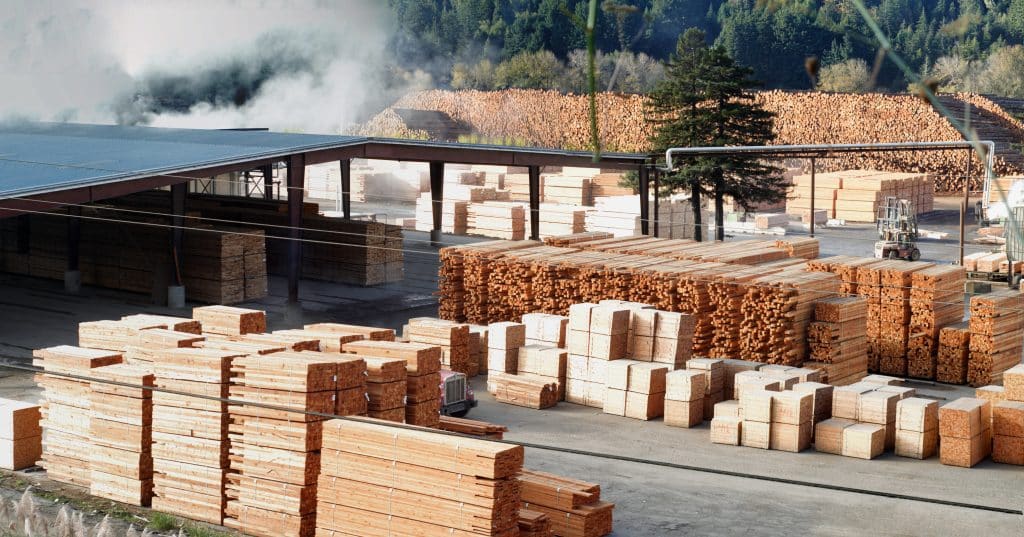
Comme l'indique la philosophie de conception de la norme CSA S-6, la sécurité est la principale préoccupation dans la conception des ponts routiers au Canada. Pour les produits en bois, la norme CSA S-6 traite des critères de conception associés aux états limites ultimes et aux états limites d'aptitude au service (principalement la déflexion, la fissuration et les vibrations). Les états limites de fatigue doivent également être pris en compte pour les éléments de connexion en acier des ponts en bois. La durée de vie de la structure dans la norme CSA S-6 a été fixée à 75 ans pour tous les types de ponts, y compris les ponts en bois. La norme CSA S-6 s'applique aux types de structures et de composants en bois susceptibles d'être utilisés sur les autoroutes, notamment le bois lamellé-collé, le bois de sciage, le bois de charpente composite (SCL), les tabliers en bois lamellé-collé, les tabliers en bois lamellé-béton, les tabliers en bois lamellé précontraint, les fermes, les pieux en bois, les caissons en bois et les tréteaux en bois. La norme ne s'applique pas aux faux-planchers ni aux coffrages. La norme CSA S-6 traite de la conception des éléments en bois soumis à la flexion, au cisaillement, à la compression et aux appuis. De plus, la norme fournit des conseils et des exigences concernant la cambrure et la courbure des éléments en bois. D'autres informations sur la durabilité, le drainage et le traitement de préservation du bois dans les ponts sont également abordées.
Bois lourd à sciage massif
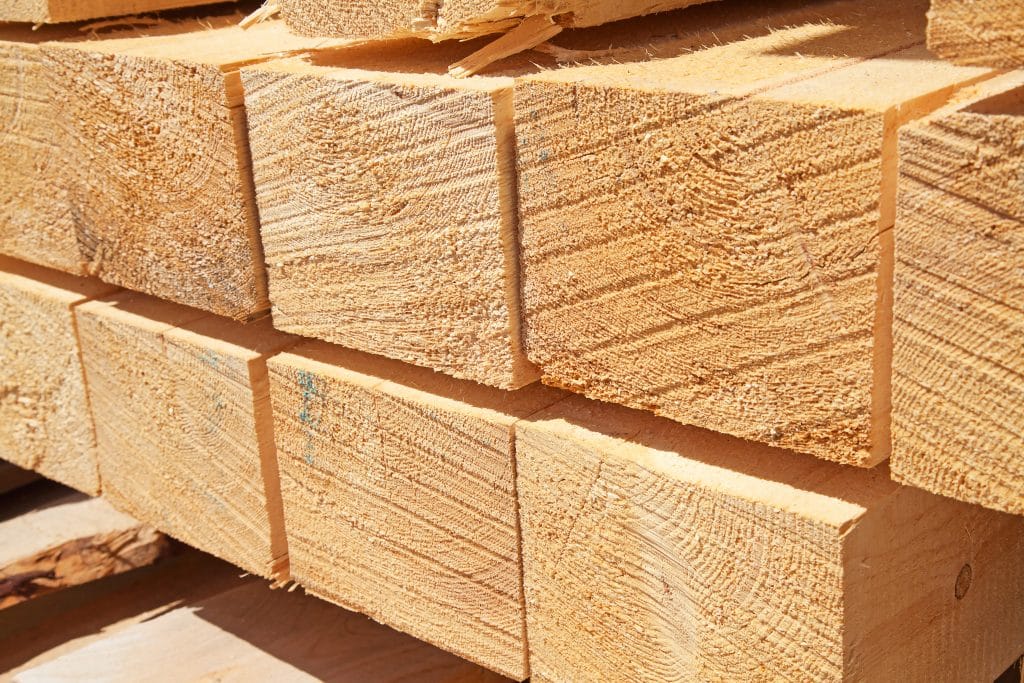
Les éléments en bois massif sont principalement utilisés comme éléments structurels principaux dans les constructions à poteaux et à poutres. Le terme "bois lourd" est utilisé pour décrire le bois massif scié dont la plus petite dimension transversale est égale ou supérieure à 140 mm (5-1/2 in). Les bois de grande dimension offrent une meilleure résistance au feu que les bois de construction et peuvent être utilisés pour répondre aux exigences de construction en bois lourd énoncées dans la partie 3 du Code national du bâtiment du Canada. Les bois sciés sont produits conformément à la norme CSA O141 Canadian Standard Lumber et classés conformément aux NLGA Standard Grading Rules for Canadian Lumber. Il existe deux catégories de bois : les "poutres et longerons" rectangulaires et les "poteaux et poutres" carrés. Les poutres et les longerons, dont la plus grande dimension dépasse la plus petite de plus de 51 mm, sont généralement utilisés comme éléments de flexion, tandis que les poteaux et les poutres, dont la plus grande dimension dépasse la plus petite de 51 mm ou moins, sont généralement utilisés comme colonnes. Les dimensions des bois sciés varient de 140 à 394 mm (5-1/2 à 15-1/2 in). Les dimensions les plus courantes vont de 140 x 140 mm (5-1/2 x 5-1/2 in) à 292 x 495 mm (11-1/2 x 19-1/2 in) en longueurs de 5 à 9 m (16 à 30 ft). Des dimensions allant jusqu'à 394 x 394 mm (15-1/2 x 15-1/2 in) sont généralement disponibles dans l'ouest du Canada dans les combinaisons d'essences Douglas Fir-Larch et Hem-Fir. Les bois des combinaisons épicéa-pin-sapin (S-P-F) et des essences nordiques ne sont disponibles qu'en petites dimensions. Les bois peuvent être obtenus dans des longueurs allant jusqu'à 9,1 m (30 ft), mais la disponibilité des bois de grande taille et de grande longueur doit toujours être confirmée auprès des fournisseurs avant la spécification. Un tableau des dimensions de bois disponibles est présenté ci-dessous. Les deux catégories de bois, poutres et limons, et poteaux et poutres, comportent trois degrés de contrainte : Select Structural, No.1, et No.2, et deux qualités sans contrainte (Standard et Utility). Les catégories de contraintes sont assorties de valeurs de calcul pour l'utilisation en tant qu'éléments de structure. Aucune valeur de calcul n'a été attribuée aux qualités non soumises à des contraintes. Les qualités No.1 et No.2 sont les plus couramment spécifiées à des fins structurelles. La qualité No.1 peut contenir des quantités variables de Select Structural, selon le fabricant. Contrairement au bois de construction canadien, il existe une différence entre les valeurs de calcul pour les qualités No.1 et No.2 du bois d'œuvre. Select Structural est spécifié lorsque l'aspect et la résistance de la plus haute qualité sont souhaités. Aucune valeur de calcul n'a été attribuée aux qualités Standard et Utility. Les bois de ces qualités peuvent être utilisés dans des applications spécifiques des codes de construction où une résistance élevée n'est pas importante, comme le blocage ou le contreventement court. Les coupes transversales peuvent affecter la qualité du bois dans la catégorie des poutres et des longerons parce que la taille autorisée du nœud varie sur la longueur de la pièce (un nœud plus grand est autorisé près des extrémités qu'au milieu). Les bois doivent être reclassés s'ils sont recoupés. Les bois ne sont généralement pas marqués (estampillés) et un certificat de l'usine peut être obtenu pour certifier la qualité. La grande taille des grumes rend le séchage au four peu pratique en raison des contraintes de séchage qui résulteraient des différences d'humidité entre l'intérieur et l'extérieur du bois. C'est la raison pour laquelle les bois sont généralement traités verts (taux d'humidité supérieur à 19 %), et le taux d'humidité du bois à la livraison dépend de l'importance du séchage à l'air qui a eu lieu. Comme le bois de construction, le bois d'œuvre commence à rétrécir lorsque son taux d'humidité tombe en dessous de 28 %. Les bois exposés à l'extérieur subissent généralement un retrait de 1,8 à 2,6 % en largeur et en épaisseur, en fonction de l'essence. Les bois utilisés à l'intérieur, où l'air est souvent plus sec, subissent un retrait plus important, de l'ordre de 2,4 à 3,0 % en largeur et en épaisseur. Dans les deux cas, la variation de longueur est négligeable. La conception et la construction doivent tenir compte du retrait anticipé. Le retrait doit également être pris en compte lors de la conception des connexions. Les petits défauts à la surface d'un bois sont fréquents dans les conditions de service humides et sèches. Ces défauts de surface ont été pris en compte dans l'établissement des résistances nominales spécifiées. Les fissures dans les colonnes n'ont pas d'importance structurelle à moins que la fissure ne se transforme en une fente traversante qui divisera la colonne. Pour de plus amples informations, veuillez consulter les ressources suivantes : Timber Framers Guild International Log Builders' Association BC Log & Timber Building Industry Association
CSA S406 Fondations permanentes en bois
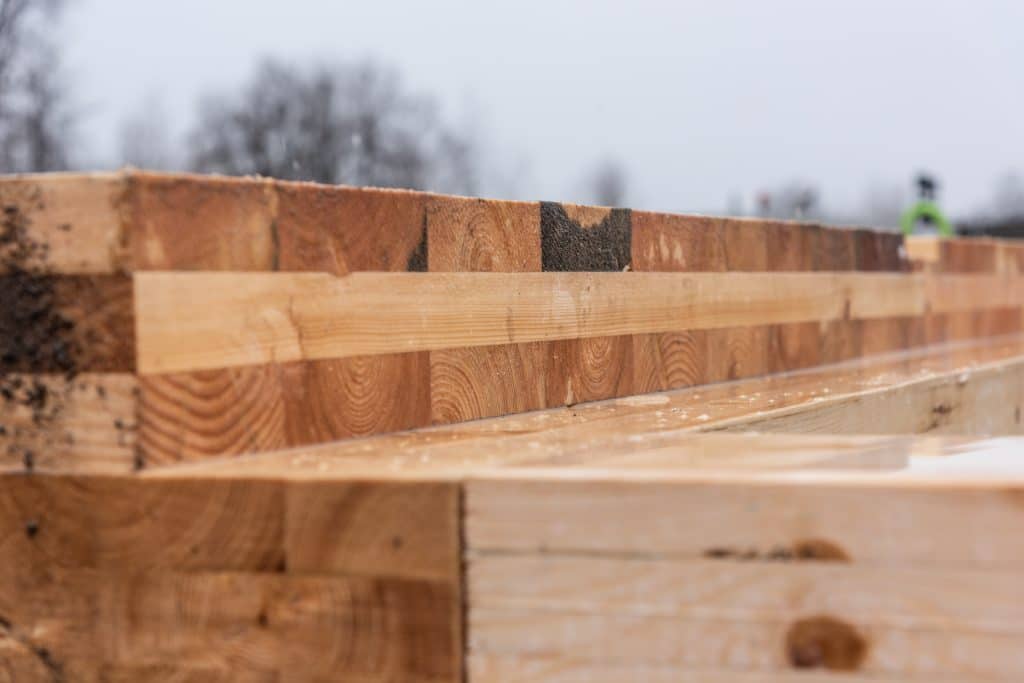
CSA S406 Spécification des fondations permanentes en bois pour les habitations et les petits bâtiments La norme CSA S406 est la norme de conception et de construction des fondations permanentes en bois (FPC) qui est citée en référence dans la partie 9 du CNB et dans les codes du bâtiment provinciaux. La première édition de la norme CSA S406 a été publiée en 1983, et les révisions et mises à jour subséquentes de la norme ont été publiées en 1992, 2014 et 2016. La norme CSA S406 s'applique à la sélection des matériaux, à la conception, à la fabrication et à l'installation de la MPO. La norme contient également des renseignements sur la préparation du site, les matériaux, le découpage et l'usinage, les semelles, les produits d'étanchéité, les barrières extérieures contre l'humidité, le remblayage et le nivellement du site. La CSA S406 fournit des détails spécifiques et des exigences normatives pour les bâtiments construits sur des MPO qui relèvent de la partie 9 du Code national du bâtiment du Canada (CNB), c'est-à-dire les bâtiments d'une hauteur maximale de trois étages au-dessus des fondations et dont l'aire de construction ne dépasse pas 600 m2. La norme CSA S406 prévoit l'utilisation facultative de systèmes de traverses en bois, de dalles de béton coulées et de planchers de sous-sol en bois suspendus en tant qu'éléments du CTP, ainsi que l'utilisation de CTP en tant qu'enveloppes de vide sanitaire. La norme n'exclut pas les CPE qui peuvent également être conçus pour des bâtiments plus grands, en utilisant les mêmes principes de conception, à condition que les exigences du code du bâtiment soient respectées. La norme CSA S406 comprend de nombreux tableaux de sélection et figures isométriques visant à améliorer l'efficacité de la conception et la compréhension des détails de construction des coffres-forts. La norme a été élaborée sur la base d'hypothèses de conception technique spécifiques concernant les procédures d'installation, le type de sol, les portées libres pour les planchers et les toits, les charges permanentes et dynamiques, les facteurs de modification, les déflexions et la hauteur de remblayage. Pour les conditions qui dépassent la portée de la norme CSA S406, des détails similaires peuvent être utilisés à condition qu'ils soient fondés sur des principes d'ingénierie reconnus qui garantissent un niveau de performance équivalent à celui énoncé dans la norme CSA S406. Si l'une des conditions de conception est différente ou plus sévère que les hypothèses, le PWF doit être conçu par un ingénieur ou un architecte et installé conformément à la norme. Indépendamment de la taille du bâtiment et de sa conformité aux hypothèses de conception de la norme CSA S406, certaines autorités compétentes exigent le sceau d'un professionnel de la conception pour délivrer un permis de construire. Pour de plus amples informations, veuillez consulter les ressources suivantes : Fondations permanentes en bois (Conseil canadien du bois) Préservation du bois Canada Code national du bâtiment du Canada
Planches de terrasse
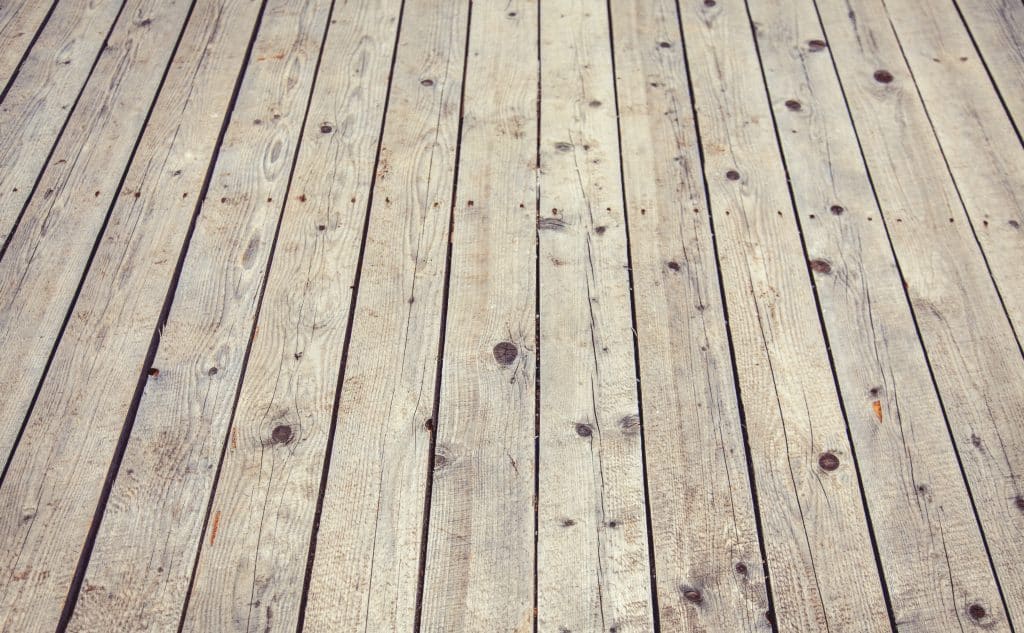
Les lames de terrasse peuvent être utilisées pour porter plus loin et supporter des charges plus importantes que les panneaux tels que le contreplaqué et les panneaux à copeaux orientés (OSB). Le platelage en planches est souvent utilisé lorsque l'apparence du platelage est souhaitée en tant qu'élément architectural ou lorsque la performance au feu doit répondre aux exigences de construction en bois lourd décrites dans la partie 3 du Code national du bâtiment du Canada. Le platelage est généralement utilisé dans les structures en bois massif ou en poteaux et poutres et est posé avec la face plate ou large sur les supports afin de fournir un platelage structurel pour les planchers et les toits. Les lames de terrasse peuvent être utilisées dans des conditions humides ou sèches et peuvent être traitées avec des produits de préservation, en fonction de l'essence de bois. Les clous et les pointes de terrasse sont utilisés pour fixer les pièces adjacentes de lames de terrasse les unes aux autres et pour fixer la terrasse à ses supports. Les lames de terrasse sont généralement disponibles dans les essences suivantes : sapin de Douglas (combinaison d'essences D.Fir-L) pruche de la côte pacifique (combinaison d'essences Hem-Fir) diverses essences d'épicéa, de pin et de sapin (combinaison d'essences S-P-F) cèdre rouge de l'Ouest (combinaison d'essences Northern) Pour produire des lames de terrasse, le bois scié est fraisé dans un profil à rainure et languette avec un usinage de surface spécial, tel qu'un joint en V. Les lames de terrasse sont généralement produites dans des matériaux de qualité supérieure, comme le bois d'œuvre. Les lames de terrasse sont normalement produites en trois épaisseurs : 38 mm, 64 mm et 89 mm. Les planches de 38 mm ont une languette et une rainure simples, tandis que les planches plus épaisses ont une double languette et une rainure. Les épaisseurs supérieures à 38 mm comportent également des trous de 6 mm de diamètre, espacés de 760 mm, afin que chaque pièce puisse être clouée à la pièce adjacente à l'aide de pointes de terrasse. Les dimensions et profils standard sont indiqués ci-dessous. Les lames de terrasse sont le plus souvent disponibles en longueurs aléatoires de 1,8 à 6,1 m (6 à 20 ft). Il est possible de commander des planches dans des longueurs spécifiques, mais il faut s'attendre à une disponibilité limitée et à des coûts supplémentaires. Une spécification typique pour les longueurs aléatoires pourrait exiger qu'au moins 90 % des planches soient de 3,0 m (10 pieds) et plus, et qu'au moins 40 % soient de 4,9 m (16 pieds) et plus. Le platelage en planches est disponible en deux qualités : La qualité Select (Sel) La qualité Commercial (Com) La qualité Select a un aspect plus qualitatif et est également plus solide et plus rigide que la qualité Commercial. Les planches de terrasse doivent être fabriquées conformément à la norme CSA O141 et classées selon les règles de classement standard de la NLGA pour le bois d'œuvre canadien. Étant donné que les planches de terrasse ne sont pas estampillées comme le bois de construction, il convient d'obtenir une vérification écrite de la part du fournisseur ou de faire appel à une agence de classement qualifiée pour vérifier le matériau fourni. Pour minimiser le retrait et le gauchissement, les lames de terrasse sont constituées d'éléments de bois sciés qui sont séchés à un taux d'humidité de 19 % ou moins au moment du surfaçage (S-Dry). L'utilisation d'un platelage vert peut entraîner le relâchement du joint à rainure et languette au fil du temps et une réduction de la performance structurelle et de la facilité d'utilisation. Les planches individuelles peuvent s'étendre simplement entre les supports, mais elles sont généralement de longueur aléatoire s'étendant sur plusieurs supports par souci d'économie et pour tirer parti d'une rigidité accrue. Il existe trois méthodes d'installation des terrasses en planches : aléatoire contrôlée, à travée simple et à deux travées continues. Une règle générale de conception pour le platelage aléatoire contrôlé est que les travées ne doivent pas dépasser de plus de 600 mm (2 pieds) la longueur que 40 % de l'expédition du platelage dépasse. Ces deux dernières méthodes d'installation nécessitent des planches de longueur prédéterminée, ce qui peut entraîner un surcoût. Profils et dimensions des lames de terrasse
CSA 080 Préservation du bois
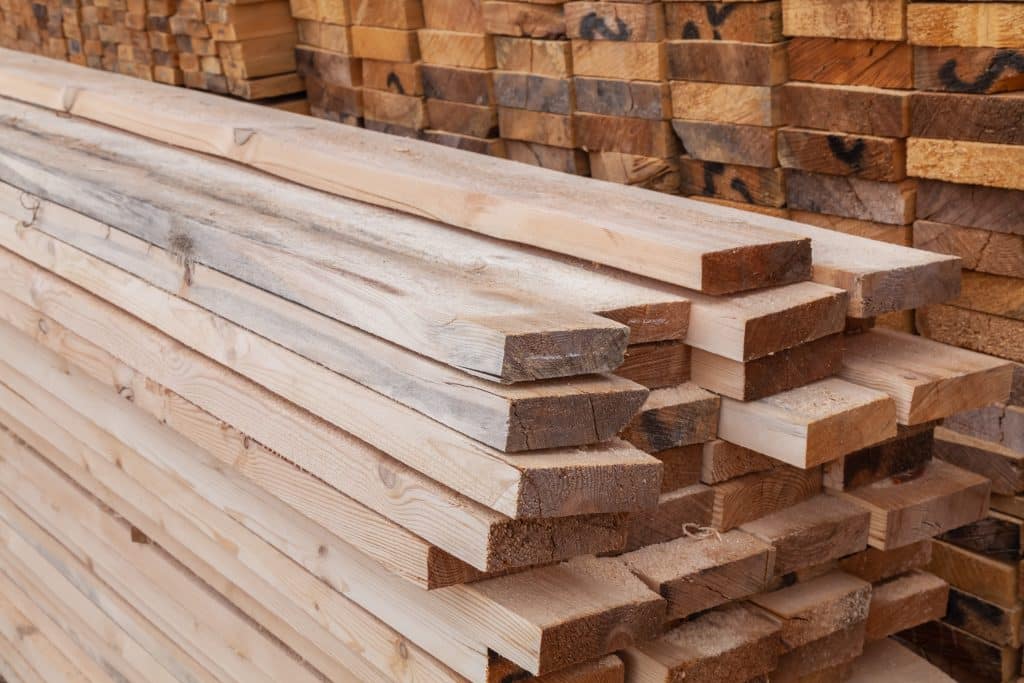
Le Code national du bâtiment du Canada (CNB) contient des exigences relatives à l'utilisation de bois traité dans les bâtiments et la série de normes CSA O80 est citée en référence dans le CNB et dans les codes du bâtiment provinciaux pour la spécification du traitement de préservation d'une vaste gamme de produits du bois utilisés dans différentes applications. La première édition de la norme CSA O80 a été publiée en 1954. Onze révisions et mises à jour de la norme ont suivi, la dernière édition ayant été publiée en 2015. La fabrication et l'application des produits de préservation du bois sont régies par les normes de la série CSA O80. Ces normes consensuelles indiquent les essences de bois qui peuvent être traitées, les agents de préservation autorisés ainsi que la rétention et la pénétration de l'agent de préservation dans le bois qui doivent être atteintes pour la catégorie d'utilisation ou l'application. La série de normes CSA O80 spécifie également les exigences relatives à l'ignifugation du bois par traitement chimique sous pression et par imprégnation thermique du bois. Les sujets généraux couverts par la série de normes CSA O80 comprennent également les matériaux et leur analyse, les procédures d'imprégnation thermique et sous pression, ainsi que la fabrication et l'installation. Les normes canadiennes relatives à la préservation du bois sont basées sur les normes de l'American Wood Protection Association (AWPA), modifiées pour les conditions canadiennes. Seuls les produits de préservation du bois homologués par l'Agence canadienne de réglementation de la lutte antiparasitaire sont répertoriés. Les pénétrations et les charges (rétentions) requises pour les produits de préservation varient en fonction des conditions d'exposition qu'un produit est susceptible de rencontrer au cours de sa durée de vie. Chaque type de produit de préservation présente des avantages distincts et le produit de préservation utilisé doit être déterminé en fonction de l'utilisation finale du matériau. Les exigences de transformation et de traitement de la série CSA O80 sont conçues pour évaluer les conditions d'exposition auxquelles le bois traité sous pression sera soumis pendant la durée de vie d'un produit. Le niveau de protection requis est déterminé par l'exposition au danger (par exemple, les conditions climatiques, le contact direct avec le sol ou l'exposition à l'eau salée), les attentes du produit installé (par exemple, le niveau d'intégrité structurelle tout au long de la durée de vie) et les coûts potentiels de réparation ou de remplacement au cours du cycle de vie. Les exigences techniques de la norme CSA O80 sont organisées dans le système de catégories d'utilisation (SCU). Le SCU est conçu pour faciliter la sélection de l'essence de bois, du produit de préservation, de la pénétration et de la rétention (charge) appropriés par le rédacteur de devis et l'utilisateur de bois traité en faisant correspondre plus précisément l'essence, le produit de préservation, la pénétration et la rétention pour des conditions d'humidité typiques et les agents de biodétérioration du bois à l'utilisation finale prévue. La norme CSA O80.1 spécifie quatre catégories d'utilisation (CU) pour le bois traité utilisé dans la construction : UC1 couvre le bois traité utilisé dans les constructions intérieures sèches ; UC2 couvre le bois traité et les matériaux à base de bois utilisés dans les constructions intérieures sèches qui ne sont pas en contact avec le sol mais qui peuvent être exposés à l'humidité ; UC3 couvre le bois traité utilisé dans les constructions extérieures qui ne sont pas en contact avec le sol ; UC3.1 couvre les constructions extérieures au-dessus du sol avec des produits en bois enduits et un ruissellement rapide de l'eau ; UC3.2 couvre les constructions extérieures en surface avec des produits du bois non enduits ou un faible écoulement de l'eau ; UC4 couvre le bois traité utilisé dans les constructions extérieures en contact avec le sol ou l'eau douce ; UC4.1 couvre les composants non critiques ; UC4.2 couvre les composants structurels critiques ou les composants difficiles à remplacer ; UC5A couvre le bois traité utilisé dans les eaux côtières, y compris l'eau saumâtre, l'eau salée et la zone de boue adjacente. La série de normes CSA O80 comprend les cinq normes suivantes : CSA O80.0 Exigences générales relatives à la préservation du bois ; précise les exigences et fournit des renseignements applicables à l'ensemble de la série de normes. CSA O80.1 Spécification du bois traité ; vise à aider les rédacteurs de devis et les utilisateurs de produits de bois traité à déterminer les exigences appropriées en matière de produits de préservation pour divers produits du bois et environnements d'utilisation finale. CSA O80.2 Transformation et traitement : spécifie les exigences minimales et les limites des procédés de traitement des produits du bois. CSA O80.3 Formulations de produits de préservation ; spécifie les exigences relatives aux produits de préservation qui ne sont pas mentionnées ailleurs. CSA O80.4 a été retirée. CSA O80.5 Additifs CCA - Poteaux utilitaires ; spécifie les exigences relatives à la préparation et à l'utilisation des combinaisons de produits de préservation et d'additifs CCA pour les poteaux utilitaires autorisés par les normes CSA O80.1 et CSA O80.2. Pour de plus amples informations, veuillez consulter les ressources suivantes : www.durable-wood.com CSA O80 Préservation du bois Préservation du bois Canada Code national du bâtiment du Canada Agence de réglementation de la lutte antiparasitaire American Wood Protection Association ISO 21887 Durabilité du bois et des produits à base de bois - Classes d'utilisation
Bois de construction composite
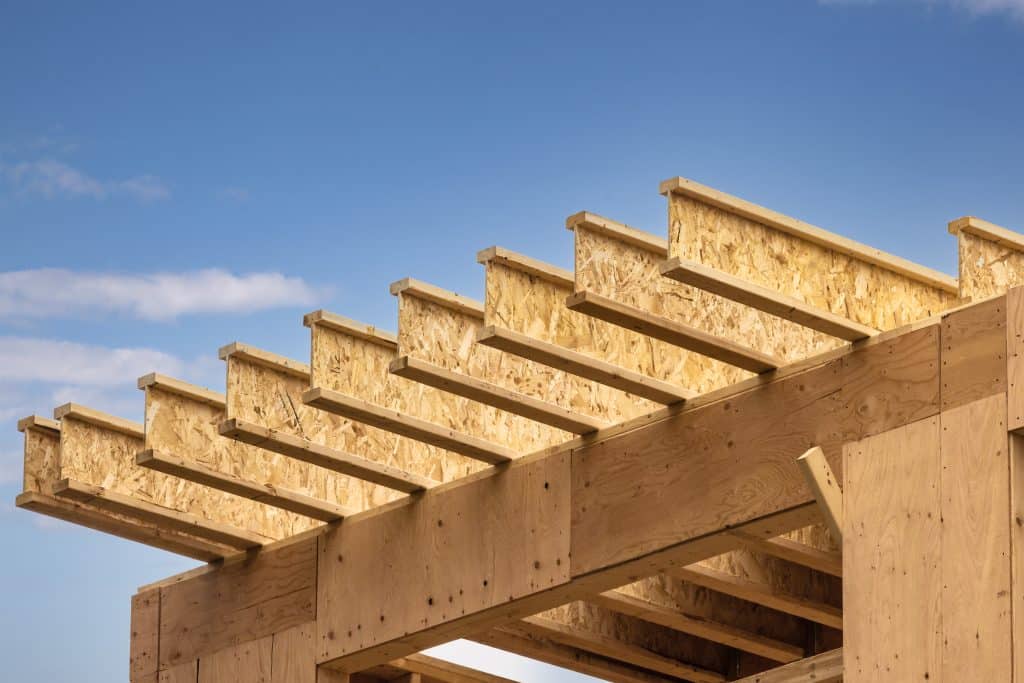
Bois de construction composite (SCL) Le bois de construction composite (SCL) est un terme utilisé pour englober la famille de produits en bois d'ingénierie qui comprend le bois de placage stratifié (LVL), le bois à copeaux parallèles (PSL), le bois à copeaux stratifiés (LSL) et le bois à copeaux orientés (OSL). Grâce à leur capacité à être fabriqués à partir d'arbres de petite taille, à croissance rapide et sous-utilisés, les produits SCL représentent une utilisation efficace des ressources forestières et contribuent à répondre à la demande croissante de produits de bois de charpente présentant des propriétés de résistance et de rigidité très fiables. Les SCL sont constitués de placages, de brins ou de flocons de bois séchés et calibrés qui sont superposés et collés avec un adhésif résistant à l'humidité pour former de grands blocs appelés billettes. Le grain de chaque couche de placage ou de flocons est principalement orienté dans la même direction. Ces billettes SCL sont ensuite sciées à nouveau dans les dimensions et longueurs spécifiées. Le SCL a été utilisé avec succès dans une variété d'applications, telles que les chevrons, les poutrelles, les solives, les membrures de fermes, les brides de poutrelles en I, les colonnes et les montants muraux. Le SCL est produit dans un certain nombre de dimensions standard. Certains produits SCL sont disponibles dans un certain nombre d'épaisseurs, tandis que d'autres ne sont disponibles que dans l'épaisseur de 45 mm (1-3/4 in). Les profondeurs typiques des éléments SCL vont de 241 à 606 mm (9-1/2 à 24 in). Les éléments SCL individuels peuvent être cloués ou boulonnés ensemble pour former des poutres construites. Généralement, le SCL est disponible en longueurs allant jusqu'à 20 m (65 ft). Le SCL est produit à un faible taux d'humidité, de sorte qu'il y a très peu de retrait après l'installation. Cette faible teneur en humidité permet également au SCL d'être pratiquement exempt de gerces, de fissures ou de gauchissements en cours d'utilisation. Les produits SCL sont des produits brevetés et, par conséquent, les propriétés techniques et les dimensions spécifiques sont propres à chaque fabricant. Par conséquent, les produits SCL n'ont pas de norme de production commune ni de valeurs de conception communes. Les valeurs de conception sont dérivées des résultats d'essais analysés conformément à la norme CSA O86 et à la norme ASTM D5456 et les valeurs de conception sont examinées et approuvées par le Centre canadien des matériaux de construction (CCMC). Les produits conformes aux directives du CCMC reçoivent un numéro d'évaluation et un rapport d'évaluation comprenant les résistances nominales spécifiées pour le produit SCL, qui sont ensuite répertoriées dans le registre des évaluations de produits du CCMC. Le nom du fabricant ou l'identification du produit et le degré de contrainte sont marqués sur le matériau à différents intervalles, mais en raison de la coupe en bout, ils peuvent ne pas être présents sur chaque pièce. Pour de plus amples informations, veuillez consulter les ressources suivantes : APA - The Engineered Wood Association Centre canadien des matériaux de construction (CCMC), Institut de recherche en construction CSA O86 Engineering design in wood ASTM D5456 Standard Specification for Evaluation of Structural Composite Lumber Products

